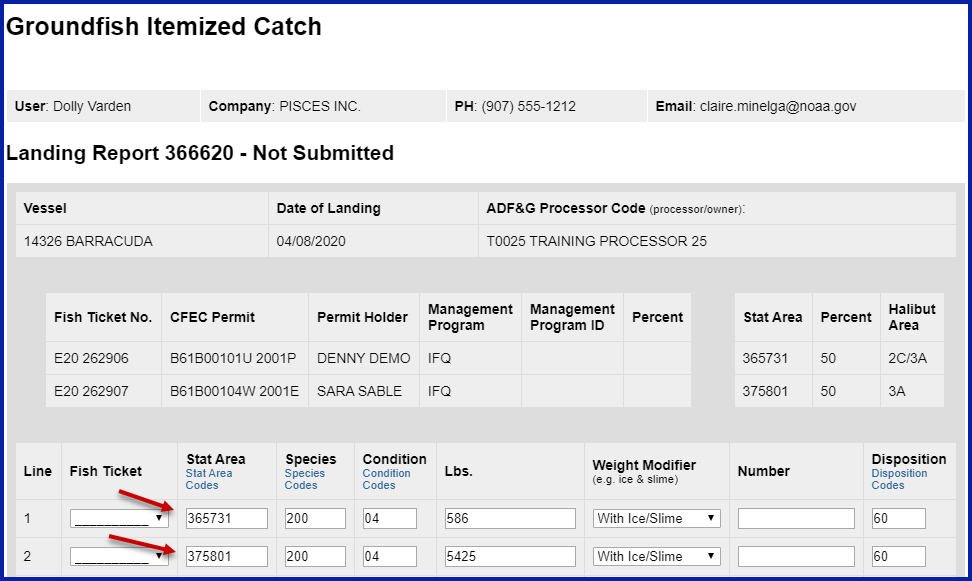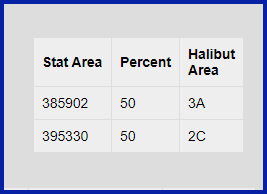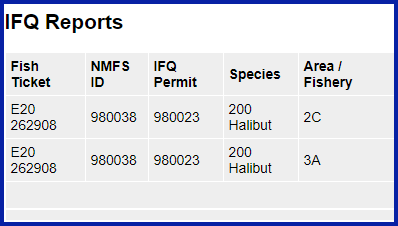| Table of Contents | ||
|---|---|---|
|
Introduction to the Allocation (Max Out) IFQ Area Feature
IFQ shareholders are assigned one permit for each species they hold quota for - sablefish or halibut. However, if a person holds quota share in multiple regulatory areas, the permit will not match up the IFQ pounds available in each area, it will display the entire QS pounds held on the permit.
Debiting of poundage to a specific regulatory area occurs within the eLandings system when users identify the state statistical area that harvest occurred in.
When the vessel crew holds multiple IFQ permits and reports harvest in more than a few statistical areas, accurately debiting specific poundage to an IFQ quota area can become quite complex.
This is especially true if quota share is held in more than one Regulatory Area for any permit holders.
The ability to debit specific poundage is crucial as permit holders approach the remaining balance of pounds on their permit. The Max-Out pounds feature allows users to assign a specific number of pounds on one IFQ permit while the remaining balance is assigned to a second or third IFQ permit that has pounds within the same regulatory area.
The eLandings System has been designed to identify the specific IFQ Area/Fishery (also known as IPHC areas) where pounds should be debited.
...
In many cases, you will not find it necessary to use the Lbs. to Max-out IFQ Permit.
Likewise, in many cases, you will not find it necessary to use the Area/Fishery identification.
In more complicated IFQ landings, you may find it necessary to manually edit the itemized catch section of the eLandings application.
This document is designed to help you determine the best method to use the application features.
When should I use the Max Out (Allocate the Area) pounds function?
When The Max out Pounds function should be used when you have two or more than one IFQ permit holder holders with quota in the same IFQ Regulatory Area, and one of the IFQ permit holders wants to allocate or max-out a specific amount of pounds on a specific permit.
When should I use the Area/Fishery identification function?
When you have more than one IFQ permit holder, in multiple IFQ Regulatory Areas, but not all the permit holders have quota in all the areas fished.
...
The third IFQ permit holder has quota only in 3A. In this case, the poundage will be divided equally for 3A harvests between the three permit holders. The 2C harvest will be allocated to the first two IFQ permit holders. The poundage amounts will be determined by the statistical areas fished and the percentage of harvest from each IFQ regulatory area.
...
Allocation (max out) IFQ Area Rules
Whether reporting IFQ or non-IFQ harvest, the information submitted to the eLandings System must be true, and an accurate reflection of fishing activity.
Feature Relationships:
The allocation to area/fishery is part of the IFQ Permit Worksheet and should only be used with IFQ halibut, sablefish, and rationalized crab fishery programs.
Within the CFEC Permit Worksheet, the percentage (1.) will divide harvest between multiple CFEC permit holders' fish tickets. If the Lbs to max-out IFQ permit feature is not used, the division of harvest, including IFQ harvest, will be divided according to the percentage established in the CFEC Permit Worksheet.
Within the IFQ Permit Worksheet, the Area/Fishery (2.) will allow you to allocate poundage to quota in a specific Regulatory Area. If you use this feature with the Lbs to max-out IFQ permit (max-out) feature, specific poundage will be debited. If you use the Area/Fishery feature without specifying poundage in the max-out feature, the percentage division will apply, but to the Regulatory Area of quota only.
...
The Statistical Area Worksheet (3.) assigns harvest pounds to specific areas. If you use this feature, the statistical areas reported must be within the Regulatory Areas where the quota is assigned.
...
The Stat Area within the itemized catch display window (4.) allows you to assign poundage to a specific stat area, and/or to a specific fish ticket, if needed. Harvest poundage assigned to a specific statistical area in the itemized catch section of the eLandings System will override the Statistical Area Worksheet (3.). Any harvest line item assigned to a specific fish ticket will override the CFEC permit Worksheet (1.) and the IFQ Permit Area/Fishery (2.) assignment.
...
Just remember, if you assign a specific fish ticket number (which is linked to a specific CFEC Permit, and/or a specific Stat Area to a specific amount of pounds) that specific assignment dominates any assignments in the Landing Report, Vessel, Permit, and Location Information of the eLandings System.
There are some circumstances shown in examples in this document when the system cannot determine how to allocate pounds to the permits. In those cases, you will be required to enter a Stat Area on the itemized catch lines.
To summarize:
Area/Fishery has to be entered when using the Max out feature
The Percentage feature allocates harvest to fish tickets.
The Area/Fishery allocates IFQ harvest to specific Regulatory areas. If the Lbs. to Max-out IFQ Permit is also used to record specific poundage, this allocation takes precedence over the percentage allocation.
The Statistical Area Worksheet allocates poundage to individual statistical areas. The allocation to the statistical area is applied to the entire catch, followed by the allocation to fish tickets by percentage. If the IFQ species are allocated in the IFQ Permit Worksheet, or in the itemized catch, this allocation affects the IFQ species and takes precedence over (overrides) the Statistical Area Worksheet and the Percentage allocation.
The CFEC Permit Worksheet is directly related to the assignment of the harvest to the fish ticket. The IFQ Permit Worksheet is directly related to the assignment of IFQ quota to specific permits and area quota.
The following examples explain the rules in greater detail:
Each NMFS ID individual or Master Operator that is selling IFQ product must have a CFEC permit, and the entire off-load shall be documented on one landing report. The eLandings System allows the user to document multiple CFEC permit/NMFS ID individuals.
Donotcreate more than one landing report for one off-load from a vessel for each CFEC Permit Holder or IFQ Permit Holder.Each IFQ quota share account must document the NMFS ID number, the IFQ Permit number, and the species associated with the IFQ permit.
If all IFQ Quota and all harvest occurred in one IFQ Regulatory Area, irrespective of the number of IFQ Permit shareholders, and no assignment of poundage to a specific permit is needed, no Area/Fishery identification is required. The eLandings System default is an equal division of poundage to each IFQ permit
...
Both permit holders have quota in the same reporting area and
...
they will equally divide the poundage of their catch. The eLandings system will automatically divide the catch and any bycatch.
...
If the Permit Holder have quota in the same reporting area but with the divide the poundage of their catch unequally, the percentage feature can be used. The eLandings system will divide the catch and bycatch. In this example, the percentages are 25/75.
...
The IFQ Permit Worksheet Lbs. to Max-out (or allocate) permit may be used only when more than one IFQ permit is associated with the landing report and with the IFQ Regulatory Area. If you want to allocate or max out the poundage the Area/Fishery must be identified and the allocated pounds. In the example below, the two IFQ permit holders have quota in 2C. The first IFQ permit holder wants to allocate (max out poundage) to 2C. The balance of the harvest from 2C will be automatically allocated to the second IFQ permit holder.
...
It is possible to allocate one IFQ Permit with quota in more than one IFQ Regulatory Area. In the example below, the two IFQ permit holders have both quota in 2C and 3A. The first IFQ permit holder wants to allocate (max out poundage) to 2C. The balance of the harvest from 2C will be automatically allocated to the second IFQ permit holder. The harvest for 3A will be split between the two permit holders.
...
Note that any additional permits for a permit holder have to have the fishery area listed if there is a max out pound allocation. The second permit holder does not have to have the fishery areas listed since there is quota in both fishery areas.
The elandings eLandings system will require you to enter statistical areas in the itemized catch lines if multiple fishery areas are used and there are limitations on some of the permits to assure that the permits are allocated properly.
Statistical Area Reporting:
The eLandings application determines automatic assignment of poundage to a specific IFQ Regulatory Area by the reported statistical area of harvest.
If you use the Statistical Area Worksheet, poundage for all harvest will be allocated to (divided between) the statistical areas by the percentages you record.
If you assign statistical areas to itemized catch these assignments will override the Statistical Area Worksheet.
The statistical areas of harvest must accurately reflect the areas of harvest and must correspond to IFQ permit quota share. As an example, you cannot request that the eLandings System assign poundage to Halibut Regulatory Area 2C if you did not fish and report a statistical area that is in this area.
If you attempt to assign poundage to IFQ Permit quota share areas that do not correspond to the reported statistical areas, an error message, such as the example below will be returned by the system.
...
In this case, the statistical areas reported on the Statistical Area Worksheet are in Halibut Regulatory Area 3B, while the Area/Fishery reported was 2C and 3A.
You can check the Regulatory area for any IFQ fishery from this link:
...
Reporting Examples:
The following are examples of how you would want to use the eLandings features to accommodate different situations:
...
The following example illustrates how to enter the permit information, stat area worksheet, and itemized catch if one of the permit holders has only a limited quota in one fishery areas and the other permit holder has quota in two fishery areas. In this example, the one permit holder has only 585 lbs in the fishery area 2C and no quota in 3A. The other permit holder has sufficient quota in both fishery areas. 6,000 lbs of halibut and 5,000 lbs of Pacific cod were caught with an equal share in two stat areas.
You can use the Lbs. to Max-out IFQ permit feature, if you want specific poundage debited from one IFQ permit Regulatory Area. To allocate poundage to a specific IFQ permit, with the above example, add the Area/Fishery and poundage for one IFQ permit quota area. The balance of the pounds from 2C will be assigned to the second IFQ permit for that Regulatory Area.
THE STATISTICAL AREAS OF CATCH ON THE STAT AREA WORKSHEET ARE:
THE ITEMIZED HARVEST:
You will have to split the halibut catch between the different stat areas and enter the statistical area on the itemized harvest. If you assign statistical areas to itemized catch these assignments will override the Statistical Area Worksheet.
...
Please note: It is necessary to assign a statistical area to the halibut harvest when there are two fisheries areas and one of the permit holder has only quota for one of them. If you do not assign the poundage that will be allocated to a specific area to a statistical area the following error message will return:
Example 6: Two CFEC permits and two IFQ permits, with quota in two regulatory areas - using max out pounds for a specific permit and area with even split of catch
The following example illustrates how to enter the permit information, stat area worksheet, and itemized catch if both permit holders have quota in two fishery areas but one of the permit holders has only a limited amount of quota in the one area and they want to split all catch evenly. In this example, the one permit holder has only 1000 lbs in the fishery area 2C and sufficient quota in 3A. The other permit holder has sufficient quota in both fishery areas. 9,000 lbs of halibut and 2,500 lbs of Pacific cod and 1,000 lbs yellowtail were caught with a 70/30 split between two stat areas. Both permit holders are going to split all catch evenly.
...
You can use the Lbs. to Max-out IFQ permit feature, if you want specific poundage debited from one IFQ permit Regulatory Area. To allocate poundage to a specific IFQ permit, with the above example, add the Area/Fishery and poundage for one IFQ permit quota area and add the second permit with no quota limitation to the first permit holder. The second IFQ permit does not need to have the fishery areas listed since there is quota in both available fishery areas.
...
The following example illustrates how to enter the permit information, stat area worksheet, and itemized catch if both permit holders have quota in two fishery areas but one of the permit holders has only a limited amount of quota in the one area and they want to split the bycatch evenly but the halibut unevenly. In this example, the one permit holder wants to use only 1,000 lbs in the fishery area 2C and 1,600 lbs in area 3A. The other permit holder has sufficient quota in both fishery areas. The other permit holder has sufficient quota in both fishery areas. 9,000 lbs of halibut and 2,500 lbs of Pacific cod and 1,000 lbs yellowtail were caught with a 70/30 split between two stat areas. The first permit holder wants to get only 2,600 lbs and the rest should go to the second permit holder.
You can use the Lbs. to Max-out IFQ permit feature, if you want specific poundage debited from one IFQ permit Regulatory Area. To allocate poundage to a specific IFQ permit, with the above example, add the Area/Fishery and poundage for the two IFQ permit quota areas for the first permit holder holder. The second IFQ permit does not need to have the fishery areas listed since there is quota in both available fishery areas.
THE STATISTICAL AREAS OF CATCH ON THE STAT AREA WORKSHEET ARE:
...
THE ITEMIZED HARVEST:
...
You will have to split the halibut catch between the different stat areas according to where the catch was caught and enter the statistical area on the itemized harvest. You will also need to enter the Fish Ticket numbers.
...
Record the one permit and the two Regulatory Areas - without indicating the poundage you wish to debit from each area. Save and navigate to the Itemized Catch window.
Create two line items, allocating the catch in the order you recorded the IFQ Permits and Area/Fishery - 2C and then 3A. You will need to identify the Stat Area for each line item.
When you generate the IFQ report, you will see that the poundage has been allocated to the two Regulatory Areas - 2C and 3A, as you desired.
Do not document the allocation of pounds within the Lbs. to max-out IFQ permit area of the IFQ Permit Worksheet. The rules of documentation within the application require that a second IFQ permit is available for each area, for the assignment of the balance of the pounds.
The program error message illustrated below will appear if you document the pounds in the Lbs. to max-out IFQ permit.
Example 9: Three CFEC permit and three IFQ permit for halibut and sablefish, with an allocation of pounds
...
The second permit holder has quota in 2C and 3A - note that the area does not have to be identified since the permit holder has quota for both areas. The third CFEC permit is for the second fisherman and is for sablefish IFQ. As all fishing took place in the SE Regulatory Area, the Area/Fishery does not need to be identified.
This example requires the recording of the stat areas and fish tickets for the halibut in the itemized catch window.
Since it is known that the 1,000 lbs for the one stat area go to the first permit holder and all of the other halibut catch goes to the second permit holder and the sablefish catch go to the third permit holder.
THE STATISTICAL AREAS OF CATCH ON THE STAT AREA WORKSHEET ARE:
...
The poundage recorded in the itemized catch is 1,331 lbs. Adjustments to whole pounds create a debit of 1,332 lbs.
Example 10: IFQ reporting of Ambiguous Statistical Areas
In the example below, the landing report consists of two CFEC and IFQ permits fishers. They fished in two statistical areas equally. One of the statistical areas was ambiguous, on the 2C/3A line. The first fisher wants to allocate poundage to the 2C area. Both fishers have quota in 2C and 3A.
Stat Areas:
...
Within the Itemized Catch window, the fish tickets and the statistical areas are identified. The Regulatory areas have been previously identified.
...
When the IFQ reports are generated, the eLandings application automatically fills in the fishery area for the ambiguous stat area for the first permit holder since it had been identified as part of the max out request. The system only prompts the user to identify the Area for the second ambiguous stat area.
When the Area/Fishery is identified, the eLandings System will be able to determine the Regulatory Area for ambiguous areas, in most cases.






















